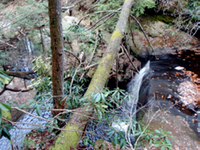
The train glides through walls of muted shades - white and grey and beige and burnt brown. Water gushes from the rock faces, spills into catch basins far below. A trestle reaches deep across a valley, and we travel the tightrope. Beneath me, a road unwinds, thin like an animal’s trail.
“Bear,”someone shouts, and there is it, lumbering in the shallows of a slate-grey river that cuts through the rock.
Here, in the Rockies, the train bends around corners, unlike prairies, where travel follows the straight and narrow. This arching of journey through landscape pleases me. I peer ahead while we navigate a curve in the track. The sight of the train rounding the bend, the long string of cars ahead of me, gives the sense of moving through time and space. The sense of journey.
I do not stay still. There is motion to my life.
I travel.
_____
Travelling alone, I’ve discovered an inner strength, an ability to take care of myself, and to entertain myself. I have no other person to depend upon to reach destination, to navigate geography, both interior and exterior. It is uncharted territory and I draw the map.
“I’m proud of you,” my husband tells me during a phone call along return journey. He is a solitary traveller himself.
The train has stopped to restock in Jasper. The temperature is near freezing and it is summer. For the first time along my trip it is truly cold, almost Canadian.
My warm clothes are packed and my luggage is checked. I scurry across the no-man’s land between the Jasper station and a strip of tourist shops to buy a sweater. The shops are quaint, and with the mountains looming, there is the sense of village in the Alps.
My cell phone is pressed to my ear, and I take in the scenery as I listen. My husband’s voice is breaking up, but I hear his words. He doesn’t have to say them, but I like that he does. I know he is proud of me. Proud of my independence. Proud of my journey. Proud of my map-making.
The cell gives a small measure of security, a link with the familiar, with home. But for most of journey, there is no service. We make contact when the train slides into larger urban centres. When the train rolls out again, the phone is dead and I am on my own.
Today, my husband and I don’t get a chance to say goodbye. The connection is cut. It is part of travel.
I shiver at the cold, push through the doors of the nearest souvenir store. There are racks of sweatshirts with Jasper stamped across them, fluffy jackets, wool sweaters. Clothes hang on the walls like pictures, and there are thick socks and moccasins for sale. I am not the only unprepared tourist. We spur an industry.
Behind glass countertops, jade jewellery. I look at the pieces wistfully, wanting to linger over them. Then I glance at the train, gauge intent, as if the train is an animal and might bolt, leave me behind.
I buy a fleece, the colour of pumpkin. Rub the material against my skin. Pull off the tags, tug on the shirt, right here in the shop. Leave the collar high around my neck, up over my chin, peer out from my shell.
I am re-enforced, ready to continue journey. Feel warm again. It is a good feeling.
Solitary travel does that, isolates things, magnifies the small sensory pleasures that get lost in everyday living, as if to say, Notice this? This, too, is what it means to be alive.
The animal on the track stirs. Hisses, then makes that jolting sound when one car is yanked into motion by another, metal against metal.
I take a final look at Jasper. Snap the photograph for my mind’s eye. Feel regret at the leaving. Promise myself to return someday. Make Jasper a destination on its own.
And I climb back up into the belly of the train.
_____
It is a different perspective, being the person in the automobile waiting at the cross guards for the train to pass. Much different from being the person sitting in the train, looking out the window, watching the automobiles wait, a long tail of them, and then passing them all by.
Sometimes I forget the bigger picture, my place in it.
From my window, I wonder why the cars are at a standstill, what keeps them from their journey, what holds them up. Maybe there has been an accident.
Then I realise with a start it is this train. The cross guards are down, the lights flash. I hold them up. They wait for me.
Maybe the real difference in perspective is between standing still and moving, between not travelling and travelling. Regardless, the passing of a train evokes response.
At first I think it is the train itself, big and powerful, but as I travel the country, I come to realise it is the passing by of the train.
The movement, the sense of journey, the adventure, the mysterious - after all, no one knows who is on that train.
Where she goes. What she does.
Why.
_____
Somewhere along journey, at a point where concrete gives way to dirt roads and farmer’s fields, a convertible, top down, stops for the train.
From the front seats, two young women wave. They are full of energy, so full of life that I’m left with the feeling the molecules vibrate within them at a higher frequency than the rest of us.
I can’t hear music, but I’ve no doubt it blares from the speakers. The two bounce, sweep arms at the train in wide arcs.
The chick in the driver’s seat wears a funny straw hat with a large brim. She makes me laugh, and I wave back. The word chick comes to mind easily. It is the perfect word to describe her. If ever there was a chick, it’s this young woman in this trendy canary-yellow sports car.
At a country outpost, an older woman out for an evening stroll waves at the train, too, but with less abandonment. It is her wild act, this little wave, I can tell by her hesitancy. But she can’t resist the urge, feels good for it. I see the response all along the route, right across the breadth of country.
In Northern Ontario, a cottage breaks through the denseness of geography, juts out of the forests and rock. There, I catch swift sight of a porch facing the passing of the train.
Two full-size figures stand shoulder to shoulder on the porch. Each raise an arm at us. I do a double take. Look quickly back. Confirm what I see. One full-size figure is a bear. The bear stands high on its back haunches, two menacing paws raised, and as big as a grizzly. The other full-size figure is a man. He stands, too, bare-chested and pot-bellied, and also grizzly. The man hikes up his beer bottle, salutes us as we pass by.
I realise with a start that the bear is not real, but a life-size woodcarving. Then I doubt my eyes, and think the man is the life-size woodcarving. Just as quickly as they come into my view, they are gone.
Later, travelling at the edge of yet one more wild and isolated lake, I see a single boat. It is a plain boat, aluminium, with a small outboard motor, a real putt-putter. A man hunches at the stern, manoeuvres the stick of the motor with one hand reaching back. A little girl sits at the bow. Both wave in unison at the passing of train.
The man and little girl, like others along the way, are located at too far of a distance to distinguish individual passengers. To know whether we travellers see them, acknowledge their actions, wave back or not. It doesn’t matter.
They wave anyway. They wave at the train, and the idea of train. There is something worthy in the journey, worthy of acknowledgment.
____
This travelogue was originally published in Stones Turned. Stories and Poems of Journey, and is part of my reflections during a trip alone by train to the West Coast.
